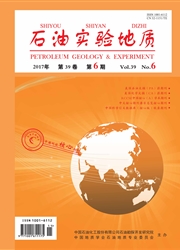

 中文摘要:
中文摘要:
低抵抗力的油层经常在因为他们的抵抗力结束,记载解释到或在附近的水层的抵抗力下面被错过。典型的低抵抗力的油层被详细探索在 Daqing placanticline 的南方在 Puao 油矿的 Putaohua 水库在过去几年里发现了。基于低抵抗力的油层的微地质的原因的研究,宏地质的控制因素通过关系与核心相结合的地区性的 depositional 背景,地质的结构,和油水的全面研究被分析,测试,很好记载,并且扫描电子显微镜学数据的水。结果证明在 Puao 油矿的 Putaohua 低抵抗力的油层的形成和分发被水库液体的 depositional 环境,沉积外形,成岩作用,烃累积的动力,和酸味和碱度控制。高固定水的浸透引起的低抵抗力的油层被免职和成岩作用控制,高免费水的浸透引起的那些被烃累积的结构的振幅和动力控制。形成水与高咸度引起的那些被古老的盐的水 depositional 控制页岩的另外的电导率引起的环境和指责的结构和那些被水库液体的古气候和酸味和碱度控制。微地质的原因和宏地质的控制因素的考虑在识别低抵抗力的油层是重要的。
 英文摘要:
英文摘要:
Low-resistivity oil layers are often missed in logging interpretation because of their resistivity close to or below the resistivity of nearby water layers. Typical low-resistivity oil layers have been found in the past few years in the Putaohua reservoir of the Puao Oilfield in the south of the Daqing placanticline by detailed exploration. Based on a study of micro-geological causes of low-resistivity oil layers, the macro-geological controlling factors were analyzed through comprehensive research of regional depositional background, geological structure, and oil-water relations combined with core, water testing, well logging, and scanning electron microscopy data. The results showed that the formation and distribution of Putaohua low-resistivity oil layers in the Puao Oilfield were controlled by depositional environment, sedimentary facies, diagenesis, motive power of hydrocarbon accumulation, and acidity and alkalinity of reservoir liquid. The low-resistivity oil layers caused by high bound-water saturation were controlled by deposition and diagenesis, those caused by high free-water saturation were controlled by structural amplitude and motive power of hydrocarbon accumulation. Those caused by formation water with high salinity were controlled by the ancient saline water depositional environment and faulted structure and those caused by additional conductivity of shale were controlled by paleoclimate and acidity and alkalinity of reservoir liquid. Consideration of both micro-geological causes and macro-geological controlling factors is important in identifying low-resistivity oil layers.
 同期刊论文项目
同期刊论文项目
 同项目期刊论文
同项目期刊论文
 期刊信息
期刊信息
